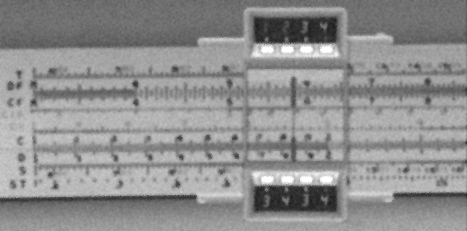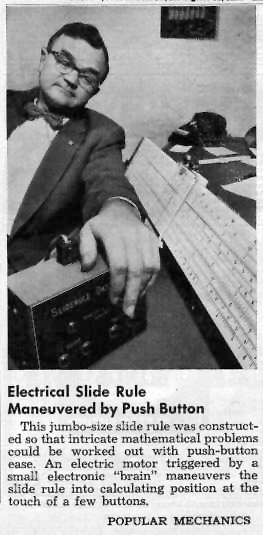Modern-day technology as applied to slide rules.
High-Tech Slide Rules
U.S.Army Tank-Rule (1971)
Recently I was contacted by Don Thule regarding a prototype Tank-Rule he had been working on in the early '70s. The prototype is shown below. Apparently, this was an attempt to merge digital readouts with the versatility of a handheld slide rule (for night-time or low-light-level reading of scales). Don's story is quite interesting … .
©U.S. Army

The prototype US.Army electronic Tank-rule.
Lieutenant Commander Donald Thule (ret), US.ARMY.
" I was a research assistant working on this project about April 1971, I think. At that time I was working for Lockheed on a Defense Department project designed to provide some improvements in computational power for tank crews.
Our initial goal was to provide an electronic calculating device for use by tank gunners and crew, generally for calculating ammunition trajectories. This task generally had to be performed in poor lighting conditions, perhaps under battle conditions with emergency lighting only.
The task was approached from several angles... We looked at the available devices which could achieve our aims, including off-the-shelf calculators. At that stage, scientific calculators were not available, and definitely not specialist electronic computation devices as capable as the many military slide rules and conversion widgets which were available.
Our research was divided into two areas; the first was to test the practicality of producing a scientific hand-held calculator, the second was to provide minimal electronic readout functionality to existing mechanical devices (ie: the general purpose and function specific slide rules). Early on, we realised we did not have the capability to produce a scientific hand-held calculator in the time available, or with the resources at hand. This team (tiger team one) was wound up approximately April 1970. I was on this second tiger team.
We developed several prototypes - using gas-fluorescent display technology and simple electronics (there were no microprocessors or ICs available at this stage), and what now seems like extremely primitive technology. The basic device was a simple resistance measuring circuit. The resistance was scaled and displayed as a 4 digit number (0 to 9999), with an implied decimal point (ie: 0.000 to 9.999). The rule was specially coated with resistive material to allow a simple 1:1 correspondence between the position of the cursor on the scale and the readout produced by the resistive circuit. Unfortunately this coating process was time consuming, expensive, and highly inaccurate.
Typically, linear scales were a breeze.. a simple layer of resistive material was placed along the entire length of the back-side of the rule in the same position as the scale (the rules we produced were single-sided). Logarithmic scales were more tricky; we had to develop a deposition process which would produce a coating of resistive material which would accurately mirror the scale values along the rule. We spent approximately 2 years developing these processes, and only managed to achieve an accuracy of about 5%. There was a lot of pressure to perform, as the Defense department was spending a lot of money on this project ($3.2 million 1971 dollars) up to the time of cancellation (see below).
We had significant other problems, apart from the resistive coating... power consumption being the major one. Due to the dual-nature of the display circuitry and the heavy power drain of the fluorescent tubules, we typically achieved 40-60 minutes of continuous operation on 2 AA cell batteries. This capacity was below the required capability of a portable calculatiion device for use in battle situations, but we were saved by the fact that the device was primarially intended for use in tanks. We added a recharging circuit, converted the cells to rechargeables, and used a standard car cigarette-lighter attachment to provide the power conversion (yes, tanks DO have cigarette lighter connections). So... the general approach was to leave the device connected to the recharging circuit while it was not in use... and then disconnect it for battle situations.
Unfortunately, this was the cause of the first major mishap for the program, and almost caused the immediate cancellation of the program. One of the test crews, using our device and charger in a tank during one of the war-game exercises, left the device connected to the charger during a long quiescent period. Our recharging circuit managed to entirely drain the tank's batteries and left one tank and crew stationary, helpless and unable to start their tank. The device did, however, produce the most accurate calculations to date, and thus saved the program by the skin of its teeth.
We were blown out of the water by the introduction of the Hewlett Packard HP35 scientific calculator in about 1972. I remember it well, the resigned feeling around the office after John Loof (my immediate boss) brought in the first one and we spent the day marvelling over it. Our project was cancelled about a week later, filed away in boxes and sent to the army. I souveniered this photograph of the last prototype we made; i have the actual device somewhere in my garage, but i haven't had it out for 20 years. The picture you see shows the dual-readout cursor, with several buttons to control the display circuitry. Included there are simple add and subtract buttons (the current reading could be accumulated to achieve automatic multiplication/division), a few reset buttons and one for displaying the scale value or the inverse scale value. In all, with the last prototype... we were nearly there... and I was sorry that this device never reached the mainstream.. it was just a few years too late.
My wife, April Thule, finally convinced me that this should see the light of day.
Motor-Driven Rules

Automatic calculations!